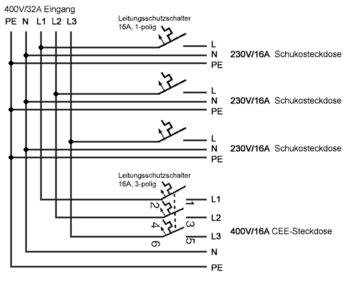CEE power distribution
A CEE power distribution is used to operate several consumers on a three-phase connection , also known colloquially as a high-voltage connection, with connector systems in accordance with IEC 60309 .
The CEE power distribution is an electrical distributor , although this term, in the narrower sense, is mainly applied to wall-mounted fuse boxes .
Connection and construction
Most mobile CEE power distributors offer several connection options:
- CEE three-phase plug connectors of various currents (16 A , 32 A, 63 A, 125 A)
- CEE AC connector (16 A, 32 A)
- Household sockets (e.g. Schuko with 230 V 16 A or SEV 1011 types 13, 15, 23 or 25)
Every necessary output is protected with a line circuit breaker with the corresponding permissible current strength and an outlet socket that protects the line from overheating. There is also a residual current circuit breaker for personal protection of all outlets, if this is still provided in the supply.
Depending on the type and number of outputs, the sum of the nominal currents of the outputs can exceed the total connected load. This excess of the total connection value is regulated in electrical installation technology by specifying a simultaneity factor and, if necessary, also specified.
In the case of power distribution with a three-phase input, the CEE alternating current and Schuko sockets are usually divided between the three outer conductors in order to achieve a symmetrical load distribution. An overloading of the distributor is prevented by the presence of an overcurrent protection device of the power socket. If a CEE power distributor is used on construction sites, it is known colloquially as a site power distributor and is often grounded locally with a rod earth in addition to the green-yellow protective conductor of the cable .
Areas of application
lighting
One application is lighting tasks in film or television productions . If for nocturnal filming with outdoor filming or for television broadcasts or television recordings in churches, halls or the like, sometimes large, in any case many lighting units are required and usually also the power supply of one or more broadcast vehicles with control console , monitors , Camera and sound technology , (possibly a separate audio OB van ), an editing mobile and also a satellite broadcasting vehicle must be guaranteed, greater services are required, which - starting from one source - must be subdivided.
This usually consists of a main connection with 3 × 63 amperes (corresponding to around 43 kilowatts at 400 V), or a power generator , followed by main and sub-distributions, up to distributors with 10 A or 16 A. Today's CEE- Power distributors made of plastic are significantly lighter than the metal distribution boxes used up until the 1970s.
Emergency operations
Another field of application for these distributor combinations are emergency operations by the fire brigade and technical relief organization for the temporary connection of auxiliary devices and lighting.
Site power distributor
CEE distributors are often used on construction sites and industrial renovation projects as a mobile switching and connection device for the power supply during construction work. A site power distributor often also contains one or more electricity meters . The supply cables are temporarily laid, for example as a 5-core flexible cable on the ground, on supports or they are routed over temporary cable bridges over access roads to the construction site.
literature
- Günter Springer: Expertise in electrical engineering . 18th edition. Europa Lehrmittelverlag, 1989, ISBN 3-8085-3018-9 .



